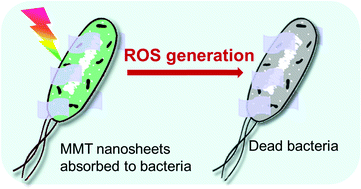Montmorillonite nanosheets with enhanced photodynamic performance for synergistic bacterial ablation†
Abstract
Montmorillonite (MMT), as a naturally sourced and FDA-approved biomaterial, has attracted considerable attention due to its extensive application in biomedical areas, such as intestinal ailments, drug delivery, and additive manufacturing. In this work, two-dimensional montmorillonite (2D-MMT) ultrathin nanosheets were successfully prepared from sodium montmorillonite (Na-MMT) by utilizing a freeze-drying assisted method. Possessing a large specific surface area and increased number of exposed hydroxyl groups, 2D-MMT nanosheets exhibited better antibacterial ability than the original Na-MMT. More strikingly, we found that both 2D-MMT nanosheets and Na-MMT could generate reactive oxygen species (ROS) upon visible light illumination, which could promote their antibacterial efficiency. As a result, 2D-MMT nanosheets showed efficient antibacterial performance in the presence of light towards Escherichia coli with a simultaneous enhancement of surface adsorption and photodynamic ablation. What's more, a possible mechanism for ROS generation by MMT upon light illumination was first proposed in this work. The combination of the increased physical adsorption capacity and ROS generation ability of 2D-MMT nanosheets would help inspire the development of MMT as a promising antimicrobial candidate in the future.



 Please wait while we load your content...
Please wait while we load your content...